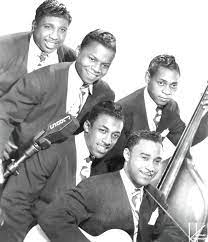
The Orioles

The Dominoes
| Pre Rock and Roll | The Transitional | R&B Dance Oriented |
 The Orioles |
 The Dominoes |
|
Other Groups
The "5" Royales were inducted into the Rock and Roll Hall of Fame in 2015 as an early influence.
The dawn of the rock and roll era was signaled by the vocal group sound. To many Doo Wop, a vocal group style, "was" rock and roll. The vocal group sound placed melody over rhythm, the song over the singer and a blending of voices over individual personality or style
Vocal group singing was the most popular style of rhythm and blues in the early 1950's, the first music to be called "rock & roll" and the favorite of the the teenagers and disc jockeys.
The "race" and "hillbilly" records had previously been listed together but, in 1949 they were renamed in the Billboard magazine. Hillbilly became Country and Western, while race became Rhythm and Blues. Rhythm and Blues was basically a cleaned up catchall term that meant "black" music aimed at a black audience."
In the late forties Rhythm and Blues was quite different in different areas of the country. Urban North rhythm and blues that had been influenced by gospel, bee-bop, jazz and black popular music was more sophisticated The instrumentation, melodies and arrangements were more complicated having been influenced by the vocal harmonies of big band and jazz sounds. The singers were more often crooners then shouters.The North rhythm and blues would evolve to a street corner sound called "Doo Wop."
![]()
The Mills Brothers and the Ink Spots were important black vocal groups that predated
the rock and roll era. The Mills Brothers were experts at imitating instruments with their
voices, while the Ink Spots Bill Kenny's quavering tenor presaged the street corner leads
of doo wop sound. Their middle of the road style of "pop" style of singing and
"white" sound that made them popular. They would serve as the role models for
the future black vocal groups.
The Ravens and The Orioles, two important inspirational groups, arrived on the scene in
the late forties.The Ravens sang with a hint of color songs rooted in jazz and rhythm and
blues. 1950's "Count Every Star" featured full range vocal backing
highlighted by wordless vocal bass lines and high falsetto that constitute the virtual
definition of doo wop.
The Orioles sang mainly ballads and sounded black. In 1953 the Orioles "Crying In the
Chapel" had an unmistakably back sound, with emotional singing, wordless
falsetto and vocal backing that reflected a trend toward a gospel style.
"Crying In The Chapel" was an important song because along with being a #1
R&B hit it also reached #11 on the Pop chart. In "crossing" over it
showed the increasing acceptance of a black style by a white audience.
Billy Ward and His Dominoes was another important group of the early fifties and is remembered for two things. First was 1951's "Sixty Minute Man" which made at to #23 on the pop charts due to sales to teenagers and secondly Ward's selection of Clyde McPhatter and his successor Jackie Wilson as lead singers.
The lyrics of "Sixty Minute Man" were considered to be shocking and vulgar in 1951.
Look-ee here girls I'm telling you now
They call me Lovin' Dan
I rock'em, roll'em all night long
I'm a sixty minute man!
If you don't believe I'm all I say
Come up and take my hand
When I let you go you'll cry,
"Oh yes, he's a sixty minute man!"
"Sixty Minute Man" reached #1 R&B and #11 on the pop charts. It was the most successful R&B record to reach that high on the pop charts and showed that black styles were becoming more accepted.